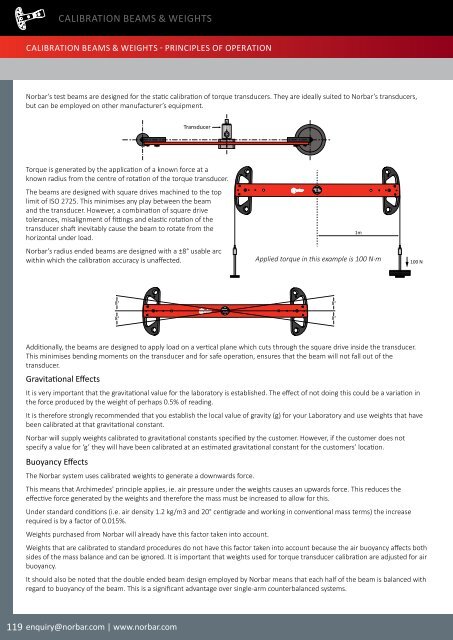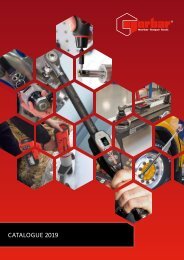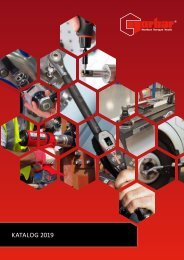Norbar Catalogue 2019
You also want an ePaper? Increase the reach of your titles
YUMPU automatically turns print PDFs into web optimized ePapers that Google loves.
CALIBRATION BEAMS & WEIGHTS<br />
CALIBRATION BEAMS & WEIGHTS - PRINCIPLES OF OPERATION<br />
<strong>Norbar</strong>’s test beams are designed for the static calibration of torque transducers. They are ideally suited to <strong>Norbar</strong>’s transducers,<br />
but can be employed on other manufacturer’s equipment.<br />
Transducer<br />
Torque is generated by the application of a known force at a<br />
known radius from the centre of rotation of the torque transducer.<br />
The beams are designed with square drives machined to the top<br />
limit of ISO 2725. This minimises any play between the beam<br />
and the transducer. However, a combination of square drive<br />
tolerances, misalignment of fittings and elastic rotation of the<br />
transducer shaft inevitably cause the beam to rotate from the<br />
horizontal under load.<br />
<strong>Norbar</strong>’s radius ended beams are designed with a ±8° usable arc<br />
within which the calibration accuracy is unaffected.<br />
1m<br />
Applied torque in this example is 100 N·m<br />
100 N<br />
8°<br />
8°<br />
8°<br />
8°<br />
Additionally, the beams are designed to apply load on a vertical plane which cuts through the square drive inside the transducer.<br />
This minimises bending moments on the transducer and for safe operation, ensures that the beam will not fall out of the<br />
transducer.<br />
Gravitational Effects<br />
It is very important that the gravitational value for the laboratory is established. The effect of not doing this could be a variation in<br />
the force produced by the weight of perhaps 0.5% of reading.<br />
It is therefore strongly recommended that you establish the local value of gravity (g) for your Laboratory and use weights that have<br />
been calibrated at that gravitational constant.<br />
<strong>Norbar</strong> will supply weights calibrated to gravitational constants specified by the customer. However, if the customer does not<br />
specify a value for ‘g’ they will have been calibrated at an estimated gravitational constant for the customers’ location.<br />
Buoyancy Effects<br />
The <strong>Norbar</strong> system uses calibrated weights to generate a downwards force.<br />
This means that Archimedes' principle applies, ie. air pressure under the weights causes an upwards force. This reduces the<br />
effective force generated by the weights and therefore the mass must be increased to allow for this.<br />
Under standard conditions (i.e. air density 1.2 kg/m3 and 20° centigrade and working in conventional mass terms) the increase<br />
required is by a factor of 0.015%.<br />
Weights purchased from <strong>Norbar</strong> will already have this factor taken into account.<br />
Weights that are calibrated to standard procedures do not have this factor taken into account because the air buoyancy affects both<br />
sides of the mass balance and can be ignored. It is important that weights used for torque transducer calibration are adjusted for air<br />
buoyancy.<br />
It should also be noted that the double ended beam design employed by <strong>Norbar</strong> means that each half of the beam is balanced with<br />
regard to buoyancy of the beam. This is a significant advantage over single-arm counterbalanced systems.<br />
119 enquiry@norbar.com | www.norbar.com







